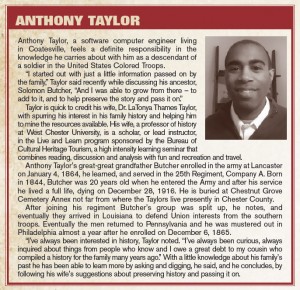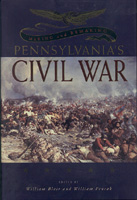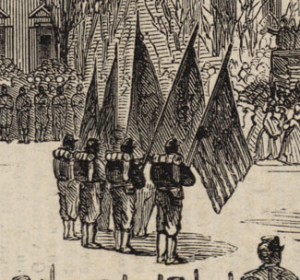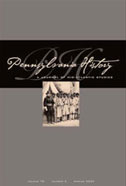
Isaac Cole (? - 1889), 32nd Regiment U.S.C.T.
(Essay written by Frank Hebblethwaite — Park Ranger, Hopewell Furnace NHS)
Abraham Lincoln referred to history as the “mystic chords of memory”. Those mystic chords of collective memory bind us together. Our common history connects us to each other in the present and to our ancestors in the past. It is a privilege to encounter those among us who instinctively recognize the importance of understanding and sharing their connections with the past in order to gain a fuller appreciation of who we are in the present.
Members of one family who have gained such an understanding of their past and have generously shared it with others are descendants of Isaac Cole, who enlisted in the Union Army in Reading, Pennsylvania on February 20, 1864 at the age of 40. The Mt. Frisby African Methodist Episcopal (AME) Church Cemetery, where Isaac Cole is buried, is located on property that has been in the Cole family since the middle of the 19th century. John Cole, Isaac’s great-grandson, and his wife Barbara, who are the current owners of the property, have graciously allowed historians, park rangers, and other researchers to visit Isaac Cole’s burial site and to examine the words and dates chiseled on his government-issued headstone. They have also participated in numerous interviews so others might learn about their family history.
While little is known of Isaac Cole’s life prior to his enlistment into the Union Army, his military and census records have left us with a good deal of information about his life after he reported for duty to Camp William Penn in Philadelphia, where he was mustered into Company H, 32nd Regiment, United States Colored Troops.
The 32nd Regiment was ordered to Hilton Head, South Carolina in April 1864 and remained on duty there until June of the same year. The regiment then moved to Morris Island, South Carolina, where they operated against Charleston. Between the end of November 1864 and the middle of February 1865, the men of the 32nd Regiment participated in an expedition to Boyd’s Neck, demonstrations on Charleston Camp, Savannah Railroad, Devaux’s Neck, and James Island, and the Battle of Honey Hill. After occupying Charleston from late February to the middle of April 1865, they took part in Potter’s Expedition, along with expeditions to Dingles’s Mills and Statesboro. Toward the end of April, the 32nd Regiment occupied Camden, Boydkin’s Mills, Beach Creek, and Denken’s Mills in rapid succession. The regiment then performed garrison duty at Charleston, Beaufort, and Hilton head, South Carolina until the middle of August. The 32nd Regiment was mustered out on August 22, 1865.
Isaac Cole’s application for an invalid pension, based on a foot injury he suffered while in camp in South Carolina, was rejected in 1887. Shortly after Isaac’s death in 1889, Continue reading →









